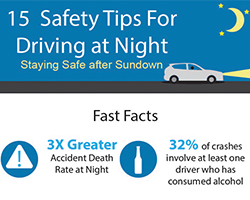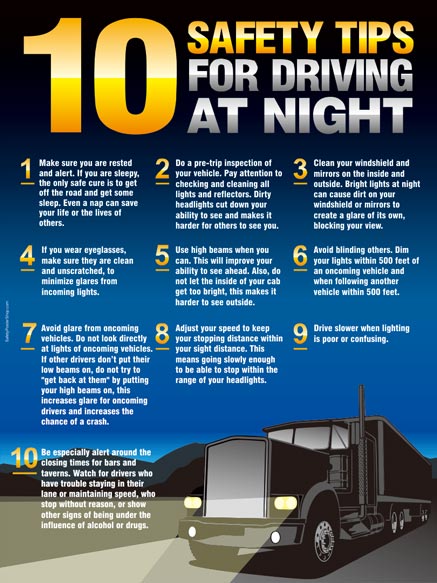As an Amazon Associate, I earn from qualifying purchases
Driving at night can be challenging and risky. Reduced visibility and fatigue are common issues.
Understanding the best practices for nighttime driving is essential for safety. Many drivers feel uneasy about hitting the road after dark. Headlights can only illuminate so much, making it hard to spot hazards. Additionally, your body’s natural rhythm slows down, making you feel sleepy.
This blog will guide you on how to navigate these challenges effectively. You’ll learn tips to enhance your visibility, stay alert, and drive confidently at night. Whether you are a new driver or experienced, these practices will help you stay safe on the road. So, let’s explore how to make your nighttime driving experience safer and more comfortable.

Credit: plg-pllc.com
Essential Night Driving Tips
Driving at night presents unique challenges. Limited visibility and increased fatigue can make it more dangerous. By following some essential tips, you can improve your safety on the road. Whether you are an experienced driver or a beginner, these tips will help you navigate the darkness with confidence.
Ensure Proper Lighting
Proper lighting is crucial for safe night driving. Check your headlights before setting out. Make sure they are clean and working. Use your high beams on unlit roads, but switch to low beams when another vehicle approaches. Keep your dashboard lights dim to reduce glare.
Adjust Your Speed
Adjusting your speed is important for night driving. Slow down to give yourself more reaction time. Speed limits are set for ideal conditions. Night driving requires more caution. Reduce your speed in areas with poor lighting or heavy traffic.

Credit: www.safetypostershop.com
Vehicle Maintenance
Driving at night can be challenging. It requires you to be more alert and cautious. One crucial aspect that can help you drive safely at night is vehicle maintenance. Proper maintenance ensures that your car is in optimal condition, improving visibility and safety. Let’s explore some best practices for maintaining your vehicle for night driving.
Check Headlights And Taillights
Your car’s headlights and taillights are vital for night driving. They illuminate the road and make your vehicle visible to others. Regularly check these lights to ensure they are working correctly. Follow these steps:
- Turn on your headlights and walk around your car.
- Ensure both headlights and taillights are illuminated.
- Replace any burnt-out bulbs immediately.
- Adjust the angle of the headlights if they are misaligned.
LED or HID bulbs can provide better visibility. Consider upgrading if your current bulbs are dim.
Maintain Clean Windshields
Clean windshields are crucial for clear visibility, especially at night. Dirt and smudges on the windshield can cause glare from oncoming headlights, reducing your visibility. To keep your windshields clean:
- Regularly clean the outside and inside of the windshield with a glass cleaner.
- Replace wiper blades every six months or when they start to streak.
- Keep the washer fluid reservoir filled with quality washer fluid.
Consider using a rain repellent product on your windshield. It can help improve visibility during rainy nights.
| Maintenance Task | Frequency | Tools Needed |
|---|---|---|
| Check Headlights and Taillights | Monthly | Replacement bulbs, screwdriver |
| Clean Windshields | Weekly | Glass cleaner, microfiber cloth |
| Replace Wiper Blades | Every 6 months | New wiper blades |
| Refill Washer Fluid | As needed | Washer fluid |
Stay Alert
Driving at night can be challenging and requires extra caution. Ensuring you stay alert is crucial to your safety and the safety of others on the road. This section focuses on the best practices to help you stay awake and attentive during nighttime driving.
Avoid Fatigue
Fatigue is one of the leading causes of accidents at night. Ensure you get enough rest before driving. Avoid long drives if you feel sleepy. Pull over at a safe location and take a short nap if needed. Drinking water can also help keep you alert. Avoid heavy meals before driving as they can make you drowsy.
Limit Distractions
Distractions can increase the risk of accidents, especially at night. Keep your phone out of reach or use hands-free devices if necessary. Adjust your radio or GPS settings before you start driving. Avoid eating or drinking while driving. Ensure that your focus remains on the road at all times. Keeping the interior of your car dark can also help reduce glare and distractions.
Use Of High Beams
Driving at night presents unique challenges. One essential tool is high beams. They provide better visibility in dark conditions. Knowing how to use them effectively ensures safety. Let’s explore the best practices for using high beams.
When To Use High Beams
High beams are helpful on dark roads. They illuminate a greater distance. Use them on highways or rural roads. Make sure there are no other cars nearby. High beams help spot hazards from afar. Animals, pedestrians, and obstacles become visible sooner.
Switching To Low Beams
Always switch to low beams around other vehicles. High beams can blind other drivers. This can lead to accidents. Change to low beams when cars approach you. Also, use low beams in foggy conditions. High beams can reflect off fog and reduce visibility. Remember, safety first.
Defensive Driving
Driving at night requires extra caution and a defensive approach. Reduced visibility and increased fatigue make nighttime driving more dangerous. Defensive driving at night can help you stay safe and avoid accidents. This section covers some of the best practices for defensive driving at night.
Keep a Safe Distance
Maintain a safe distance from the car in front of you. This gives you more time to react to sudden stops. At night, it is harder to judge distances, so increase the following distance. A greater distance ensures you have enough time to react to any unexpected situation.
Be Aware Of Wildlife
Wildlife is more active at night. Animals can suddenly appear on the road. Be vigilant, especially in rural areas. Slow down in areas where wildlife is common. Use your high beams when there is no oncoming traffic to spot animals early. This gives you more time to react and avoid a collision.
Navigating Poor Weather
Driving at night becomes more challenging with poor weather conditions. Reduced visibility and slippery roads can make driving dangerous. Adopting best practices can ensure safety for you and others on the road.
Driving In Fog
Fog can significantly reduce visibility. To drive safely in fog, follow these tips:
- Use fog lights: These lights help you see better and make your car more visible to others.
- Reduce speed: Slowing down gives you more time to react to any obstacles.
- Keep a safe distance: Maintain a greater distance from the car in front to avoid collisions.
- Avoid high beams: High beams reflect off the fog, making it harder to see.
Handling Rainy Conditions
Rainy weather can cause slippery roads and poor visibility. Here are some tips to stay safe:
- Check wipers: Ensure your wipers are in good condition to clear the windshield effectively.
- Use headlights: Turn on your headlights to improve visibility and let others see you.
- Reduce speed: Wet roads can be slippery, so drive more slowly to maintain control.
- Maintain tire tread: Good tire tread helps prevent hydroplaning and provides better traction.
- Avoid puddles: Driving through deep water can cause your car to lose control.
Following these practices can make a significant difference in ensuring your safety while driving in poor weather at night.
Dealing With Glare
Driving at night can be challenging due to glare. Keep your windshield clean and use anti-glare mirrors. Adjust your headlights properly to improve visibility.
Driving at night presents unique challenges. One of the most common issues is dealing with glare from oncoming headlights. Glare can reduce visibility and make it difficult to see the road clearly. Here are some best practices to help you manage glare and drive safely.
Use Your Visor
Your car’s visor isn’t just for blocking the sun. At night, it can also help reduce glare from oncoming headlights. Adjust your visor to block the light from entering your eyes directly. This simple trick can make a big difference in your night driving experience.
Clean Your Mirrors
Dirty mirrors can scatter light and increase glare. Make sure your mirrors are clean before you start driving. Use a soft cloth and a good cleaner to wipe them down. Clean mirrors provide a clearer reflection and help you see better at night. This small step can significantly improve your visibility and reduce glare. By following these tips, you can drive more safely at night and reduce the risk of accidents.

Credit: www.linkedin.com
Emergency Preparedness
Driving at night requires extra caution and alertness. Ensure headlights are clean and properly aimed. Keep a safe distance from other vehicles and reduce speed.
Driving at night can be challenging. It’s important to be prepared for emergencies. Having the right knowledge and supplies can make a big difference. This section will help you get ready for any situation on the road.
Carry Essential Supplies
Always have a flashlight with extra batteries. It helps you see in the dark. Keep a first aid kit in your car. It can be useful in case of minor injuries. Have a blanket or warm clothes. Nights can get cold, especially if you’re stuck on the road. Carry some non-perishable snacks and water. They can sustain you during a long wait. A basic tool kit is also important. It can help you fix small issues with your car.
Know Emergency Procedures
Familiarize yourself with emergency contact numbers. Know how to reach roadside assistance. Practice changing a tire. It can save you in case of a flat. Learn how to jump-start your car. A dead battery can leave you stranded. Understand the basics of car maintenance. It helps in identifying problems early. Always inform someone about your route. It helps others find you if needed.
Frequently Asked Questions
What Are The Top Tips For Night Driving?
Ensure your headlights are clean and working. Keep your windshield clear. Reduce speed and stay alert.
How Can I Improve My Night Vision While Driving?
Use anti-reflective lenses if needed. Dim your dashboard lights. Avoid looking directly at oncoming headlights.
Why Is Driving At Night More Dangerous?
Reduced visibility and increased fatigue make night driving risky. Wildlife and intoxicated drivers are also more common.
What Should I Do If I Feel Tired While Driving At Night?
Take regular breaks. Drink coffee or an energy drink. If very tired, find a safe place to rest.
Conclusion
Safe night driving requires attention and caution. Follow these best practices for a safer journey. Always keep your headlights clean. Use high beams wisely. Stay alert and avoid distractions. Slow down in unfamiliar areas. Regularly check your eyesight. Proper vehicle maintenance ensures safety.
Rest well before driving. Avoid alcohol and stay hydrated. Stay vigilant for pedestrians and animals. By following these simple tips, you can drive safely at night. Remember, safety always comes first. Happy driving!
As an Amazon Associate, I earn from qualifying purchases


